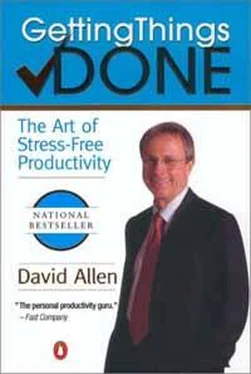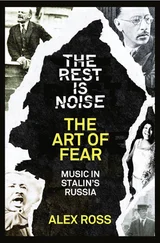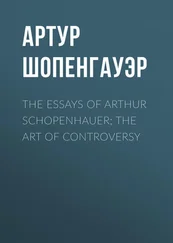"Errands" It makes a lot of sense to group together in one place reminders of all the things you need to do when you're "out and about." When you know you need to get in your car and go some-where, it's great to be able to look at the list while you're on the road. Actions like "Get stock certificates from safety-deposit box," "Pick up pictures at framers," and "Buy petunias at nursery" would all go here.
This list could, of course, be nothing more elaborate than a Post-it that you keep in your planner somewhere, or a screen in an "Errands" category of the "To Do" section on your Palm organizer. It's often helpful to track sublists within individual "Errands" items. For instance, as soon as you realize you need something from the hardware store, you might want to make "Hardware Store" the list item and then append a sublist of all the things you want to pick up there, as you think of them. On the low-tech end, you could create a "Hardware Store" Post-it; on the high-tech side, if you were using a digital list, you could attach a "note" to "Hardware Store" on your list and input the details there.
We must strive to reach that simplicity that lies beyond sophistication
— John Gardner
Because I travel in major metropolitan areas so much, I keep two "Errands" lists — "Errands—Ojai" (where I live) and "Errands—Anywhere," for all those other things I can pick up even when I'm on the road. "T-connectors for irrigation" would go on "Errands—Ojai," but "Get dress socks" would go on "Errands—Anywhere."
"Office Actions'/"At Office" If you work in an office, there will be certain things that you can do only there, and a list of those will be a useful thing to have in front of you then—though obviously, if you have a phone and a computer in your office, and you have"Calls" and "At Computer" as separate lists, they'll be in play as well. I'd use an "Office Actions" or "At Office" list for anything that required an Internet connection available only, or even most conveniently, in the office—for example, a reminder to download a large software program from the Web would go on this list for me.
"At Home" Many actions can be done only at home, and it makes sense to keep a list specific to that context. I'm sure you've got numerous personal and around-the-house projects, and often the next thing to do on them is just to do them. "Hang new print," "Organize CDs," and "Switch closets to winter clothes" would be typical items for this grouping.
If you have an office at home, as I do, anything that can be done only there goes on the "At Home" list. (If you work only at home and don't go to another office, you won't need an "Office Actions" list at all—the "At Home" list will suffice.)
"Agendas" Invariably you'll find that many of your next actions need to either occur in a real-time interaction with someone or be brought up in a committee, team, or staff meeting. You have to talk to your partner about an idea for next year; you want to check with your spouse about his schedule for the spring; you need to delegate a task to your secretary that's too complicated to explain in an e-mail. And you must make an announcement at the Monday staff meeting about the change in expense-report policies.
Standing meetings and people you deal with on an ongoing basis may need their own "Agenda" lists.
These next actions should be put on separate "Agenda" lists for each of those people and for that meeting (assuming that you attend it regularly). Professionals who keep a file folder to hold all the things they need to go over with their boss already use a version of this method. If you're conscientious about deter-mining all your next actions, though, you may find that you'll need somewhere between three and fifteen of these kinds of lists. I recommend that separate files or lists be kept for bosses, partners, assistants, spouses, and children. You should also keep the same kind of list for your attorney, financial adviser, accountant, and/or computer consultant, as well as for anyone else with whom you might have more than one thing to go over the next time you talk on the phone.
If you participate in standing meetings—staff meetings, project meetings, board meetings, committee meetings, whatever—they, too, deserve their own files, in which you can collect things that will need to be addressed on those occasions.
Often you'll want to keep a running list of things to go over with someone you'll be interacting with only for a limited period of time. For instance, if you have a contractor doing a significant piece of work on your house or property, you can create a list for him for the duration of the project. As you're walking around the site after he's left for the day, you may notice several things you need to talk with him about, and you'll want that list to be easy to capture and to access as needed.
Given the usefulness of this type of list, your system should allow you to add "Agendas" ad hoc, as needed, quickly and simply. For example, inserting a page for a person or a meeting within an "Agenda" section in a loose-leaf notebook planner takes only seconds, as does adding a dedicated "Memo" in a PDA's "Agenda" category.
"Read/Review" You will no doubt have discovered in your in-basket a number of things for which your next action is to read. I hope you will have held to the two-minute rule and dispatched a number of those quick-skim items already—tossing, filing, or routing them forward as appropriate.
To-read items that you know will demand more than two minutes of your time are usually best managed in a separate physical stack-basket labeled "Read/Review." This is still a "list" by my definition, but one that's more efficiently dealt with by grouping the documents and magazines themselves in a tray and/or portable folder.
For many people, the "Read/Review" stack can get quite large. That's why it's critical that the pile be reserved only for those longer-than-two-minute things that you actually want to read when you have time. That can be daunting enough in itself, but things get seriously out of control and psychologically numbing when the edges of this category are not clearly defined. A pristine delineation will at least make you conscious of the inventory, and if you're like most people, having some type of self-regulating mechanism will help you become more aware of what you want to keep and what you should just get rid of.
It's practical to have that stack of reading material at hand and easy to grab on the run when you're on your way to a meeting that may be late starting, a seminar that may have a window of time when nothing is going on, or a dentist appointment that may keep you waiting to get your teeth cleaned. Those are all great opportunities to crank through that kind of reading. People who don't have their "Read/Review" material organized can waste a lot of time, since life is full of weird little windows when it could be processed.
Those who make the worst use of their time are the first to complain of its shortness.
—Jean de
Organizing "Waiting For"
Like reminders of the actions you need to do, reminders of all the things that you're waiting to get back from or get done by others have to be sorted and grouped. You won't necessarily be tracking discrete action steps here, but more often final deliverables or projects that others are responsible for, such as the tickets you've ordered from the theater, the scanner that's coming for the office, the OK on the proposal from your client, and so on. When the next action on something is up to someone else, you don't need an action reminder, just a trigger about what you're waiting for from whom. Your role is to review that list as often as you need to and assess whether you ought to be taking an action such as checking the status or lighting a fire under the project.
Читать дальше











